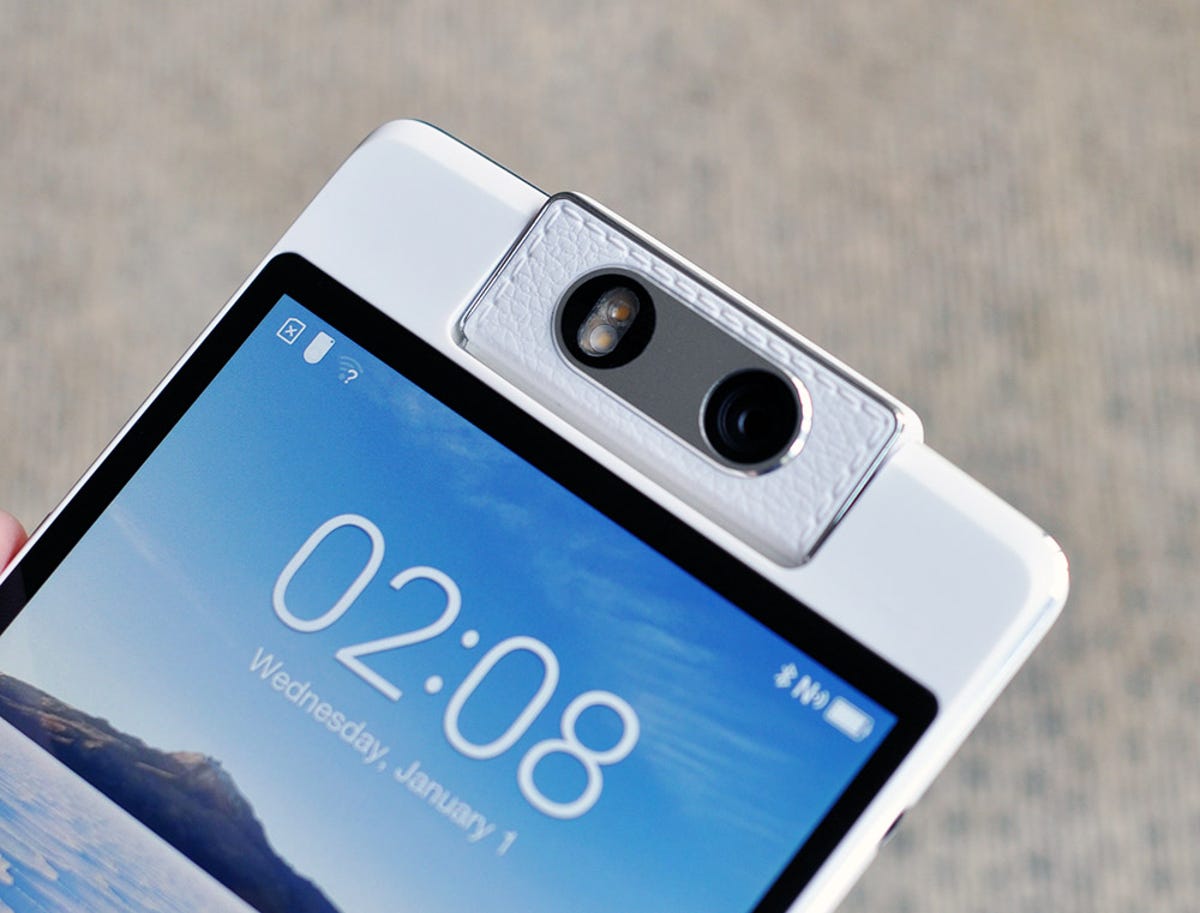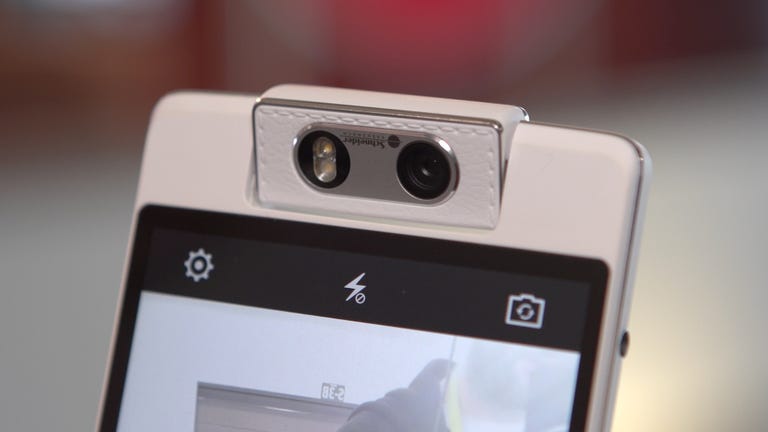 Why You Can Trust CNET
Why You Can Trust CNET Oppo N3 review: Twist again: Oppo improves on its swivel camera phone
The successor to the Oppo N1 skips a number and comes with an updated design -- including a motorized, rotating leatherette camera. No, really.
Let's be honest, most smartphones have very similar features -- a longish rectangular body, powerful chips and a camera on the front and back, albeit with different megapixel counts. Oppo went out on a limb last year with the N1, whose camera was mounted on a swivel. This year's flagship from the Chinese company has the same gimmick, but it's been improved with a motor and a nifty auto-panorama feature.
The Good
The Bad
The Bottom Line
Novelties usually come with drawbacks, however. The camera module is separate from the chassis, making for a thicker phone, and unlike the slim and lightweight devices you see from its competitors, Oppo's N3 feels thick and heavy.
The phone will be available globally direct from Oppo's online shop for $649 or €549 (with free shipping), which converts to around £410, unlocked and without a contract. The US version of the phone will work with GSM carriers such as AT&T and T-Mobile for calls and texts, while the international model should work on all networks in the UK, Australia and Singapore. LTE support will vary by country, so make you check that it matches your carrier's network before buying.
Design
While the name suggests the N3 is the the third version of the company's N series, it's actually the second. Oppo skips even numbers in its model lines -- I'm guessing this might be due to how Chinese companies prefer to avoid the number four (since the pronunciation of "four" in Mandarin sounds like "death").
The N3 looks much the same as the N1, though there are tweaks to the design. The most obvious of these is the faux-leather material used in the swivel camera mount. I'll be honest here -- I hate it. It clashes with the rest of the phone's clean matte surface and doesn't add anything to the character of the N3. Nothing good, anyway.

The swivel camera has been improved with a motor, and it automatically turns around when you tap on the front camera button in the camera app. You can slide your finger on the screen or fingerprint sensor (located at the back) to operate the camera and there's an auto-panorama feature. Check out the camera's leatherette-swivelling action in the GIF below.
Oppo has added a band at the sides, and while it does look stylish, it ends up digging into your hand, making for an uncomfortable grip. The phone appears to taper downwards, making the bottom look thinner than the top.
The bottom has an odd-looking hollowed-out curve -- that's Oppo's Skyline notification bar, which first appeared on the Oppo Find 7 . The notification lights can now be seen even when the phone is placed with the screen facing downwards, as they're now visible on both sides of the phone, leaving you unable to escape notifications unless you hide it in your pocket or a drawer.
Like most Chinese-made smartphones, the N3 has dual-SIM capability -- one micro-SIM slot and one nano-SIM slot, although this model isn't available in every region. The "international" version replaces the nano-SIM slot with a microSD slot so you can expand the storage with up to 128GB.
The fingerprint sensor on the rear works just like the Touch ID sensor on Apple's iPhone. There's no need for a swiping action to use your fingerprint to unlock the device. Simply touch it with the correct finger and the phone automatically unlocks. The only problem with using the sensor is its placement on the back -- when the phone is on the table, you'll have to unlock it by picking it up or entering the PIN code. In this regard, putting the sensor on the front, like the iPhone does, makes more sense.
Unusually, Oppo has given this sequel a smaller screen. Whereas the Oppo N1 had a huge 5.9-inch display, the N3 comes with a smaller full HD (1,920x1,080-pixel) 5.5-inch screen. It's large enough that you may have trouble typing with one hand, but it works great for watching videos.
Because of the smaller screen, the N3 has a smaller footprint, at 161 by 77mm (6.3 by 3 inches). The Oppo N3 is slightly thinner than the N1, at 8.7mm to the N1's 9mm (0.34 to 0.35 inches). It's also pretty heavy at 192 grams (6.8 ounces).
Software and other features
The N3 comes with Oppo's own Color OS 2.0, running over Android 4.4 KitKat. The OS has been improved, and while it's slightly flatter than before, Oppo hasn't taken the plunge to fully commit to the flat interface found on many current Android devices. That said, you can download skins from the Theme Store and change its look.
Oppo has made the N1's gesture feature much more usable. Instead of swiping down from the top-left corner and taking up the whole screen, the gesture window can now be activated by swiping upwards from the bottom of the screen, which only takes up about a third of the display.
This makes it much easier to use and you can set up patterns to launch things like the camera, the flashlight, or a different app of your choosing.
One thing to note is that like most Chinese-designed Android interfaces, there's no app drawer, so everything is on the home screen, like on Apple's iOS.
The N1's O-Click accessory has been redesigned too. This small, circular dongle pairs with the N3 via Bluetooth and now packs directional buttons that let you control the swivel camera, so you can set up the phone on a tripod. It can be used to locate your phone as well.
Camera
The Oppo N1 had a pretty good camera, and (leather aside) the N3 is no disappointment. The 16-megapixel shooter comes boasting reputable Schneider Kreuznach optics, and the camera performs admirably. Check out the test shots below.
Performance and hardware
Packing a 2.3GHz Qualcomm Snapdragon 801 processor, 2GB of RAM and 32GB of onboard storage, the N3 did pretty well in benchmarks. In Quadrant, the N3 scored 19,783, while in Linpack, the N3 managed 1,271 MFLOPs. Both scores compare favorably with other handsets such as the Xiaomi Mi Note or the HTC One M8 .
Mind you, benchmarks aren't always a good indicator of how the phone performs in actual use, as manufacturers have been known to sometimes jigger with the settings so they do better in such tests. That said, the Oppo N3 ran smoothly and I didn't notice any lag in my time with it.
Quadrant benchmark scores
Battery
Packing a non-removable 3,000mAh battery, the phone lasted 12 hours and 26 minutes in our CNET Labs Video Test. That's pretty respectable, and reflects the full days of use I got out of it.
Call quality and speakers
Oppo's speakers are pretty loud, so you'll want to turn down the volume to avoid annoying your colleagues in the office. I found voice calls to be clear and crisp, though there was one incident where the audio had some distortion, but I suspect that was the fault of the carrier here in Singapore, since it was fine once I hung up and called again.
Conclusion
Oppo's second take on its innovative swivel-camera phone comes with a few compromises -- namely a smaller display and a thicker body -- but the new camera is almost good enough to justify the hefty $649 price tag.
But if you're particular about design, the Oppo N3 probably isn't for you. Compared with the well-crafted Oppo R5, the N3 feels thick and bulky. It's not a phone for everyone, but it's innovative and the motorised swivel camera is a fun feature you won't find on other high-end devices.


